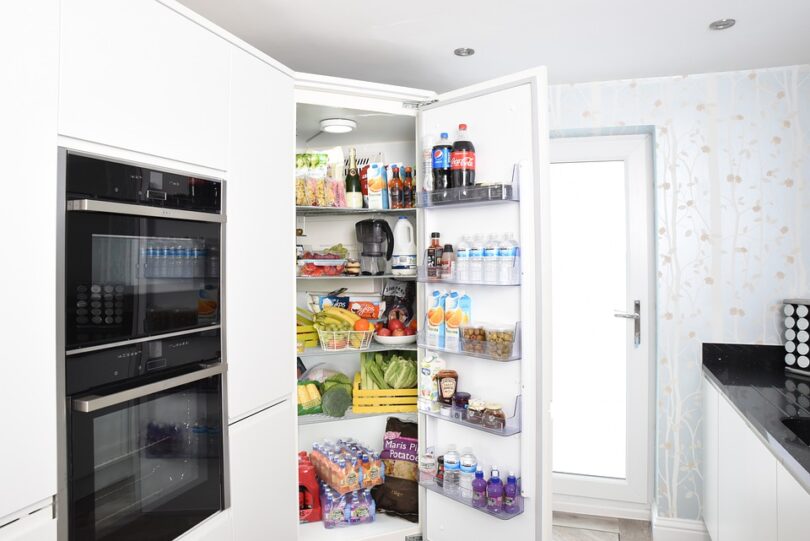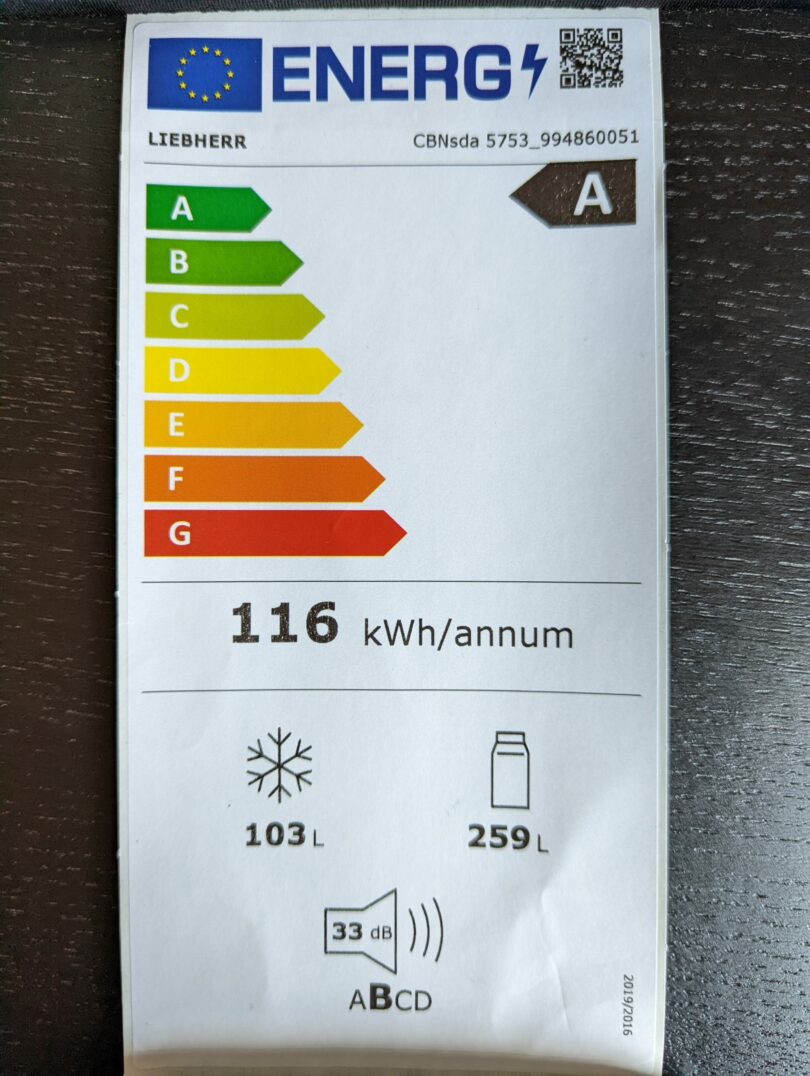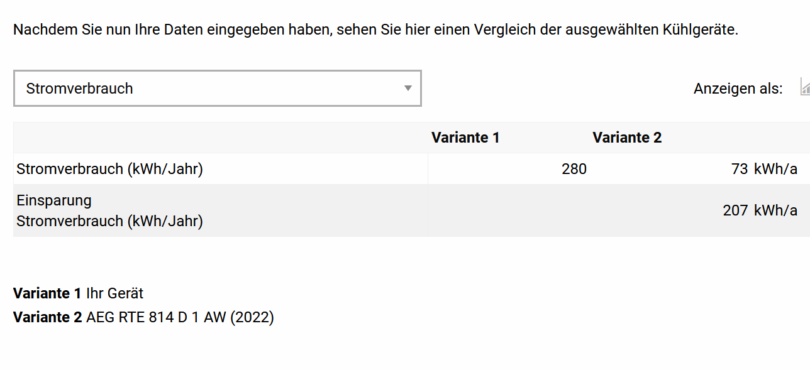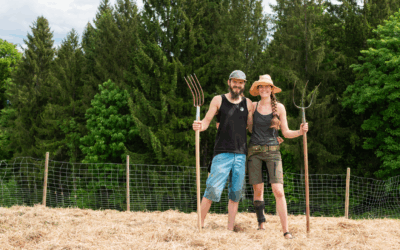Original post by barb on October 31, 2022. Translated by Lisa Scheer in 2023/24.
Disclaimer: Some of the links in this post might redirect you to a site in German. Feel free to use Machine Translation (such as DeepL or Google Translate) to get the information provided on these sites.
Everything on sustainably cooling food with your fridge
These days almost every single apartment has a fridge. To have your fridge consume less energy and so that only foods end up in the fridge that need cooling, we can do quite some things. That’s why we are going to have a closer look at fridges and their function on this page.
Size matters
For one to two people a fridge that has a volume of 100 to 160 litres is sufficient. For every additional person, 30 to 40 litres can be added. If you know which foods belong into the fridge, you will be able to reduce its size.
Stocked optimally
To not cool unused space in the fridge, it should be properly stocked. But pay attention: If it is too full, it will use more energy and you can lose sight of what you have in it. Therefore, food is more likely to go bad.
The perfect fit
Standalone units without a freezer need the least amount of electricity. Built-in devices need more energy and the coolest models with an integrated freezer need up to one forth more of the energy than one without a freezer. To freeze food, a chest freezer is recommended, as it is 10 to 15 percent more efficient than a freezer.

The ideal place for your fridge
The cooler the place where the fridge is, the less energy it uses. It’s best to avoid places near stoves, heaters, washing machines or dishwashers and to not have it in direct sunlight. Built-in devices should have big, uncovered ventilation slits and be at a distance of around 5 centimetres from walls.
Energy class

EU energy label has an energy efficiency scale that ranges from A to G. Category A refers to the most energy-efficient appliance. It’s best to choose a device from categories A to C. If you have a look at the comparative figures, it truly does make sense. A fridge-freezers combination of category A takes 22 percent less energy when compared to a one of category B. Compared to category C it even uses 37 percent less. More information on the EU energy label can be found here.
The best temperatures inside your fridge
There is no need for fridge to have arctic temperatures. It is sufficient to have the inside of your fridge be 6 to 7 degrees Celsius cold. If you turn up the temperature by one number, you the inside of your fridge is two degrees warmer but you can save up to 12 percent of energy costs. A freezer should have a temperature of -18 degrees Celsius.
Sealing rubber of the door of the fridge
It is important for sealing rubbers to be intact. They should remain smooth and supple. If they are hard, brittle or even broken and do not seal properly anymore, cold escapes from the fridge. The fridge now has too cool more to reach its operating temperature. You will notice this through higher electricity bills. We recommend cleaning the sealing rubber with warm water and dish soap regularly (do not use strong detergents) and to check them. Every now and then you can put glycerine (chemist’s) or old lip balm on it or powder it with talcum (baby powder).
Once the sealing rubber is porous and brittle, you can only replace it. To do so, read the manual of your fridge. You can find standard sealing rubbers in hardware stores or original sealing rubbers at fridge manufacturers. To check if the sealing rubber is still intact, you can place a turned-on flashlight with its light facing the door inside the fridge. Shut the fridge, darken your kitchen and have a look. If the light is visible from the outside, the sealing rubber no longer works properly, and warmth gets into the fridge while the cold escapes. You should replace the rubber sealing at this point.
More practical tips:
- Let warm foods cool down before putting them in the fridge.
- Defrost regularily – more than five millimetres of ice in the freezer can make the energy use go up by up to 30 percent. Moreover, the optimal cooling temperature is no longer guaranteed and the storage space also gets smaller.
What’s the best way to defrost?
- Turn off the appliance, pull out the plug.
- Take the food out (place it somewhere cool)
- put a bowl of hot water in the fridge or freezer and shut the door
- When the ice has melted, wipe the inside and let it dry
- Turn the fridge or freezer back on and when the ideal temperatures are back, put the food back in.
Properly using cold zones within the fridge
Different foods need different temperatures. If you want to know more about this, feel free to check for information online.
Tips for properly stocking your fridge:
Vegetable compartment:
Vegetables, herbs, lettuce and sensitive fruits, such as grapes or cherries, prefer the compartments at the bottom of the fridge.
Lower storage compartment:
The glass tray above the vegetable compartment is the coldest. Put your perishable foods, such as meat, fish and sausages there. This place is also ideal to carefully defrost frozen foods.
The golden middle:
For milk and various dairy products and delicatessen.
Upper storage compartment:
It is the warmest and is reserved for jams, prepared food and hard cheese.
Door of the fridge:
Next to the extra compartments for eggs (which can be stored at room temperatures as well) and butter, you can place drinks of all kinds (except for milk, because it’s too warm there) here. Moreover, you can place opened jars and bottles of dressing, pickles, and more here.
Fruit and vegetables – in the fridge or out?
Potatoes, garlic, pumpkin, lemons, mangoes, melons, bananas, avocados and vegetables with high water contents, such as cucumbers, courgette, aubergine, peppers and tomatoes do not belong in the fridge. Unless there is a cellar compartment for foods that do not handle the cold well inside the fridge.
Which kinds of vegetables belong into the fridge? How do you package them? (Bild: unsplash)
More practical tips for fruit and vegetables:
- Wrap fresh herbs, lettuce and vegetables such as chard, radishes, asparagus and spinach in a wet cloth to keep them fresh for longer periods of time.
- Do not wash berries to store them in the fridge. Wash them before eating them.
- Unfavourable neighbours: apples, pears, bananas, nectarines, peaches and tomatoes which are the biggest producers of ethylene (ripening gas). Do not store them with cucumbers, cabbage or carrots, as these will ripen more quickly and spoil.
- Remove greenery from radishes, carrots and other vegetables before storing them, because greenery removes water and vitamins from the vegetable.
General practical tips for the usage of your fridge
- Put foods with a best before date that’s further away at the back of the fridge. Put those with a closer date in the front and create your own „Eat-me-first“-space.
- Package all your foods properly, so don’t store them opened, but keep them in their original packaging, in jars or cans, covered with a plate or other things in the fridge.
- For a snack or breakfast, keep a very own box in the fridge that can be taken out at once instead of grabbing every single food on its own.
- Only open your fridge for short periods of time. Think about what you want to take out beforehand.
- Keep the same order in the fridge, so that family members know, where they can find specific foods in the fridge.
- Do you really need everything that you have been keeping in your fridge for months? If no, bring it to a Foodsharing-Fairteiler. Someone else will be happy about it.
Is it time to get a new fridge?
All goodbyes are hard but sometimes we gain from them. Your old fridge might have considerably higher CO2-emissions and energy costs than a new one. If a new fridge pays off and if you can create fewer CO2-emissions, can be found out here: co2online.de This website also shows you a list of fitting new devices. This page offers some information in English, but this calculator is in German. Feel free to use Machine Translation to understand the program better.

„Effizienz Check“ App calculates the costs based on the lifetime of a fridge and explains energy labels. A comparison of different products is also possible.
Power consumption meter
You can check the real energy consumption of any appliance yourself with a power consumption meter. You put it between the outlet and the plug of the appliance and you can reliably read about energy consumption and energy cost that come with the appliance. The results can help when deciding if a new appliance is necessary and where the energy guzzlers within the house hide.
A second chance for your fridge
Your fridge no longer works as it once did, and you think it deserves a second chance? You can have it repaired for less money by using the Repair bonus.
To properly part ways
If you have made the decision to finally part ways with your fridge, you can get it to an environmentally friendly recycling process by either getting back to the original vendor or by bringing it to a collection point:
- Ressourcenpark of Holding Graz, Sturzgasse 8
- Vendors with a store space of more than 150m2 when buying a new appliance
Can we do without a fridge?
If you search for tips on a life without a fridge on the internet or look it up in books, you might feel like pulling the plug of your fridge (at least in colder months). If you look into it, you will learn a lot about making food last longer, which foods need to be cooled, which storage methods are the best and how to build your powerless fridge yourself.
For example, you can get a sand box for carrots and radishes can be stored in water with their greenery pointing downwards. If you have an earth cellar, you already are well on your way. Using a drum of a washing machine that you put in the earth or by a cooler on the balcony can replace a fridge. A mini-fridge made from two flower pots with sand between them is also an idea for the balcony.
It’s interesting to try as you get the chance to get closer to food and to understand what some food needs.
Sources:
- https://praxistipps.focus.de/leben-ohne-kuehlschrank-tipps-wie-sie-lebensmittel-frisch-halten_128327
- https://www.lecker.de/kuehlschrank-richtig-einraeumen-was-gehoert-wohin-70651.html
- https://mediamag.mediamarkt.at/detail/tipps-kuehlen-gefrieren
- https://mediamag.mediamarkt.at/detail/kuehlschrank-so-ordnen-sie-lebensmittel-richtig.html
- https://mediamag.mediamarkt.at/detail/gemuese-fruechte-kuehlschrank.html
- https://kleinerleben.de/leben-ohne-kuehlschrank/
- https://www.hyggelust.de/2018/10/28/ein-leben-ohne-k%C3%BChlschrank-total-verr%C3%BCckt-oder/
- https://www.hausjournal.net/kuehlschrankdichtung-pflegen
- https://www.t-online.de/heim-garten/haushaltstipps/id_85461652/haushaltstipp-so-pflegen-sie-die-dichtungen-ihres-kuehlschranks.html
- https://www.hausjournal.net/kuehlschrankdichtung-reinigen
Anmerkung der NiG-Redaktion:
Falls du keine wichtigen Beiträge oder Termine von uns verpassen willst, abonnier doch bitte gerne unseren Newsletter! Er kommt unregelmäßig und nicht zu häufig – versprochen. Oder schau regelmäßig in unseren Veranstaltungskalender.
Wenn dir gefällt, was wir auf dieser Plattform tun, nämlich bereits seit 2017 über Nachhaltigkeit, Umwelt- und Klimaschutz zu informieren, dann unterstütz uns doch bitte auch finanziell, um unsere Website in dieser Qualität und Fülle weiterführen zu können – uns hilft jeder Beitrag!
Verein „Nachhaltig in Graz“
BIC: STSPAT2GXXX
IBAN: AT20 2081 5000 4200 1552
Verwendungszweck: Spende/Sponsoring (Mehr zum Sponsoring hier)
Du kannst dir auch gerne unsere kostenlose App aufs Handy laden, damit kannst du Informationen, Veranstaltungen und vieles mehr entdecken: App Nachhaltig in Graz












